Red light therapy improves your blood cell health through its powerful effect on cellular mitochondria. When you expose your body to red light, it stimulates mitochondrial function, boosting ATP production – the essential energy source for all cells, including blood cells. This increased energy helps blood cells perform crucial functions like oxygen transport, immune response, and maintaining proper circulation. The therapy also promotes nitric oxide production, which enhances blood flow and vessel health, while reducing inflammation that can impair blood cell function. Understanding these cellular mechanisms reveals just how deeply red light therapy can transform your body's critical systems.
Mitochondrial Function in Blood Cells

Powerhouses within our cells, mitochondria play a vital role in blood cell health and formation. If you're looking to understand blood cell development, you'll need to recognize that mitochondria control the fate of hematopoietic stem cells by preventing the production of 2-hydroxyglutarate (2HG), a compound that can disrupt normal blood cell generation when elevated.
You'll find that mitochondria are especially critical in producing specific blood cells, like red blood cells (erythropoiesis). During this process, balanced ROS levels maintain stem cell functionality and proper development. While healthy mature red blood cells typically lose their mitochondria, some conditions like sickle cell disease (SCD) retain them, leading to increased oxidative stress and immune complications.
When it comes to white blood cells, particularly neutrophils, you'll see that mitochondria are essential for multiple functions. They maintain NADPH levels for respiratory burst, produce ATP through oxidative phosphorylation for chemotaxis, and regulate cell adhesion and migration.
If you inhibit mitochondrial function, you'll notice reduced neutrophil migration speed and impaired chemotaxis. These processes demonstrate why mitochondrial health is fundamental to maintaining proper blood cell function and immune response.
Cellular Energy and Blood Health
Your body's blood cells need ATP to power essential functions like maintaining membrane stability and protecting against oxidative stress.
The Embden-Meyerhof pathway is solely responsible for generating ATP in red blood cells.
When your mitochondria are working at their best, they produce the energy your blood cells require to carry out repairs and maintain proper function.
You'll get the most benefit from your body's natural healing processes when your cells can generate and use energy efficiently.
ATP Powers Blood Function
The essential molecule ATP serves as the primary energy currency for blood cells, powering essential functions that keep your blood healthy and efficient. In red blood cells, ATP production occurs through glycolysis in the cytosol, since these cells lack mitochondria. You'll find that each glucose molecule processed through the Embden-Meyerhof pathway yields 2 ATP molecules, providing essential energy for cellular maintenance. During periods of high cellular energy demands, your blood cells can hydrolyze 100 to 150 moles of ATP daily to maintain proper functioning.
| ATP Function | Purpose | Impact |
|---|---|---|
| Membrane Support | Maintains integrity | Preserves cell shape |
| Electrolyte Balance | Controls gradients | Regulates cell volume |
| Protection | Prevents oxidation | Protects proteins/hemoglobin |
| Signaling | External messaging | Controls blood vessel tone |
Your blood cells use ATP for vital processes like maintaining membrane phospholipid asymmetry and protecting metabolic enzymes from oxidative damage. When oxygen levels drop, your red blood cells release ATP as a signaling molecule, triggering blood vessel dilation to improve oxygen delivery. The body carefully regulates ATP levels through enzymes called ectonucleotidases, which break down excess ATP into other molecules like adenosine, ensuring proper vascular function and preventing potential complications.
Mitochondrial Health Drives Production
Inside healthy blood-producing cells, mitochondrial function drives the complex process of hematopoiesis, where new blood cells form and mature. Mitochondria's ability to generate ATP powers this essential process, and when they're functioning effectively, you'll maintain strong blood cell production and better overall health.
The connection between mitochondrial health and blood cell formation is critical, as these cellular powerhouses recycle ATP thousands of times to maintain your body's continuous energy. As people age, mitochondrial DNA mutations can significantly impact blood cell production and lead to various types of anemia. You'll find that proper mitochondrial function prevents the buildup of harmful compounds like 2-hydroxyglutarate, which can interfere with blood cell generation.
Here's how healthy mitochondria support your blood cell production:
- They enable proper iron utilization and heme biosynthesis during red blood cell development
- They maintain energy levels needed for cellular differentiation and maturation
- They prevent oxidative stress that can damage developing blood cells
- They support vitamin B and riboflavin metabolism essential for blood cell formation
When your mitochondria aren't working properly, you might experience anemia, fatigue, and other blood-related disorders. That's why maintaining mitochondrial health is essential for sustaining proper blood cell production and function.
Energy Boosts Cell Repair
When cellular energy levels ramp up through red light therapy, blood cells gain remarkable repair capabilities thanks to enhanced ATP production. Your cells begin to function more efficiently as the therapy enhances cellular respiration and oxidative phosphorylation, creating a steady stream of energy to power crucial repair processes.
Red light therapy stimulates the production of new mitochondria, ensuring your cells maintain consistent ATP energy production. The therapy breaks up nitric oxide bonds that typically compete with oxygen, allowing hydrogen ions to move more freely and generate higher ATP levels. This process directly supports your blood cells' ability to repair and regenerate.
As your cellular metabolism improves, you'll experience reduced oxidative stress, which often leads to cell damage and death. The enhanced ATP production creates a protective environment where your blood cells can thrive and maintain their essential functions.
Through improved blood flow and reduced inflammation, your cells receive better nutrition and oxygen delivery, supporting their repair mechanisms. These combined effects create an ideal environment for cellular regeneration, helping your blood cells maintain peak performance and health.
Blood Flow Enhancement Mechanisms
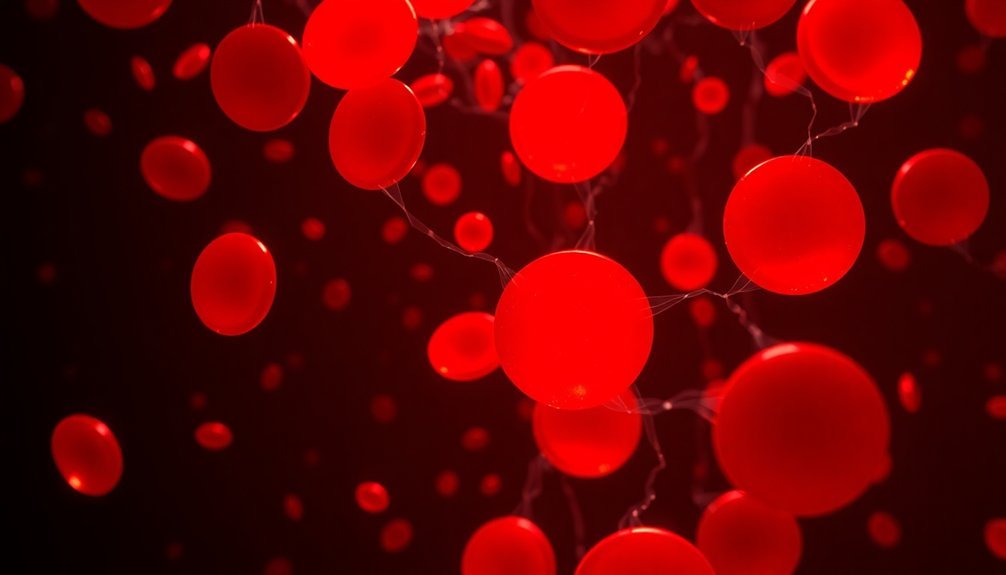
Red light therapy boosts your blood flow by triggering the release of nitric oxide, a natural compound that helps your blood vessels expand and relax.
You'll experience improved microcirculation as the therapy stimulates the formation of new capillaries, allowing for better oxygen and nutrient delivery to your tissues.
Nitric Oxide Production Benefits
Understanding nitric oxide's role in blood flow enhancement reveals its remarkable impact on cardiovascular health. When your body produces nitric oxide, it triggers a cascade of beneficial effects that improve your overall circulation and wellness.
You'll experience enhanced blood flow as this molecule relaxes and widens your blood vessel walls, leading to better oxygen and nutrient delivery throughout your body.
For athletes and fitness enthusiasts, nitric oxide offers significant performance advantages. You'll notice improved physical capacity as your muscles receive more oxygen and nutrients during exercise. Plus, the increased blood flow helps maintain healthy, flexible blood vessels while reducing strain on your heart through lowered blood pressure.
Here are the key benefits you'll gain from ideal nitric oxide production:
- Enhanced athletic performance through better oxygen delivery to muscles
- Improved cardiovascular health with reduced blood pressure
- Better sexual function due to increased blood flow
- Stronger immune response through improved macrophage activity
Your body's nitric oxide production doesn't just support physical performance – it's also vital for neurological function, acting as a neurotransmitter that influences brain activity and learning processes.
Regular exercise helps maintain healthy nitric oxide levels, making it an essential component of your overall health strategy.
Microcirculation Optimization Methods
Multiple mechanisms work together to enhance your microcirculation and improve blood flow throughout your body. Your resistance arteries actively respond to various signals, including metabolic byproducts and hormones, to regulate blood flow to specific tissues.
When you need increased circulation, your blood vessels dilate through the relaxation of vascular smooth muscle cells, which is controlled by specific cellular pathways involving cGMP and cAMP.
Your red blood cells play a vital role as oxygen sensors, working with S-nitroso hemoglobin to trigger NO-dependent vasodilation where it's needed most. This process is particularly important in areas with low oxygen levels, where your body needs to increase blood flow.
The endothelial cells lining your blood vessels respond to shear stress by releasing nitric oxide and prostacyclin, which further promote vasodilation. You'll find this process enhanced during exercise, when increased metabolic demands trigger the breakdown of ATP to adenosine, a natural vasodilator.
Your body maintains effective microcirculation through a delicate balance of these mechanical, hormonal, and metabolic factors, ensuring proper tissue perfusion and cellular health.
Inflammatory Response and Circulation
While inflammation serves as the body's natural defense mechanism, chronic inflammation can lead to various health issues that red light therapy effectively addresses.
When you undergo red light therapy, it helps balance inflammation by stimulating your mitochondria to produce ATP energy and reduce oxidative stress. This process works alongside improved blood circulation, as the therapy triggers the release of nitric oxide, widening your blood vessels and capillaries.
You'll experience several key benefits when red light therapy enhances your circulation and manages inflammation:
- Your blood vessels dilate, allowing oxygen-rich blood to reach damaged tissues more effectively
- Your cells receive more nutrients through optimized blood flow, supporting faster healing
- The increased circulation helps flush out inflammatory compounds from affected areas
- Your body's natural healing processes accelerate due to enhanced cellular energy production
The combination of improved circulation and reduced inflammation creates a powerful healing environment in your body. This therapeutic approach is particularly effective because it's working at the cellular level, optimizing your blood cells' function while supporting your body's natural healing mechanisms through enhanced blood flow and reduced inflammatory response.
Immune System Support
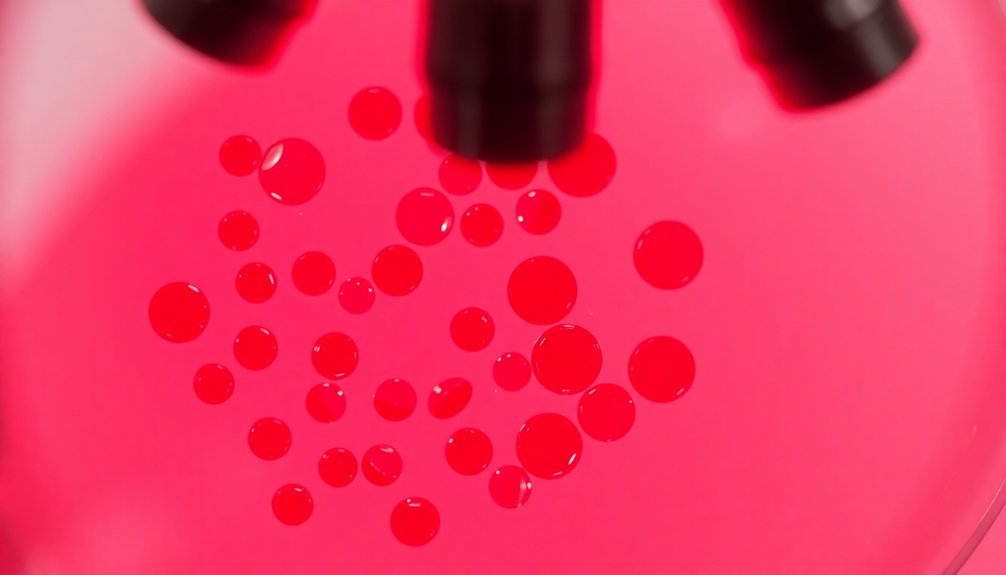
Red light therapy's immune-boosting power stems from its ability to energize and enhance your body's defense mechanisms at the cellular level. When red and near-infrared light penetrates your tissues, it stimulates your mitochondria, leading to increased ATP production – the essential energy currency your immune cells need to function effectively.
This enhanced cellular energy directly impacts your immune system's performance. Your leukocytes and lymphocytes become more active and efficient, producing more antibodies to fight off harmful invaders like bacteria and viruses.
As your immune cells receive this energy boost, they're better equipped to defend your body against infections and diseases.
You'll also benefit from reduced physiological stress as your cells operate more efficiently with their increased energy supply. This efficiency allows for faster recovery from illnesses and injuries, while supporting peak immune function.
The therapy's ability to stimulate angiogenesis improves blood flow, ensuring your immune cells receive proper nutrition and oxygen.
What makes red light therapy particularly appealing is its non-invasive, drug-free approach to immune support. Through photobiomodulation, you're strengthening your immune system naturally, without concerning yourself with medication side effects.
Blood Cell Regeneration Benefits
Building on its immune-supporting properties, light therapy's influence extends into the domain of blood cell regeneration through powerful cellular mechanisms. Red light therapy targets your mitochondria and enhances stem cell activity, particularly through photobiomodulation that boosts ATP production.
When specific wavelengths of red light reach your cells, they activate cytochrome c oxidase, triggering a cascade of beneficial cellular responses.
Your blood cells benefit from red light therapy in several key ways:
- Enhanced stem cell proliferation and differentiation, especially in mesenchymal stem cells (MSCs) that support blood cell production
- Increased production of essential compounds like reactive oxygen species, nitric oxide, and cyclic adenosine monophosphate that promote cell growth
- Improved hematopoietic recovery, which is vital if you've undergone radiation therapy
- Accelerated blood cell regeneration through mechanopriming of MSCs on bone marrow-like surfaces
The non-invasive nature of LED-based red light therapy makes it an attractive option for supporting blood cell health. Multiple exposures at 630 nm wavelength can provide sustained enhancement of cell growth, though you'll need consistent treatment sessions for effective results.
Oxidative Stress Management
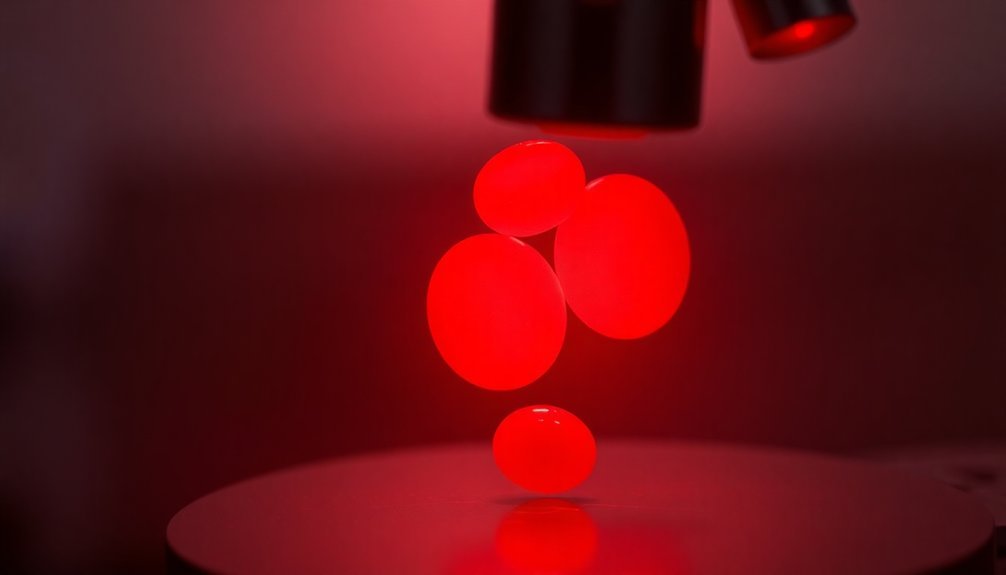
Your body's ability to manage oxidative stress plays a crucial role in maintaining healthy blood cells. When free radicals overwhelm your antioxidant defenses, your red blood cells become particularly vulnerable due to their limited protective mechanisms and lack of organelles.
Red light therapy offers a powerful solution for managing oxidative stress in your blood cells. It works by activating your cellular metabolism and boosting ATP production, which strengthens your body's natural antioxidant defenses.
The therapy's deep-penetrating red wavelengths reach interior cells, triggering protective mechanisms that help your blood cells combat oxidative damage.
You'll find that combining red light therapy with other oxidative stress management strategies can enhance its effectiveness. Consider incorporating antioxidant supplements like ascorbic acid and N-acetylcysteine, which directly support red blood cell quality.
If you're receiving stored blood, know that modern blood banks are implementing techniques like anaerobic storage and antioxidant additives to reduce oxidative stress during storage.
Clinical evidence supports red light therapy's role in reducing oxidative stress, making it a valuable tool for protecting your blood cells from damage caused by radiation, pollution, and other environmental stressors.
Vascular Health Optimization
While optimizing vascular health requires a thorough approach, integrating proper diet, exercise, and lifestyle modifications creates a powerful foundation for maintaining healthy blood vessels. You'll need to focus on antioxidant-rich foods, heart-healthy fats, and proper hydration while limiting sodium and alcohol intake.
Regular physical activity, including aerobic exercises and strength training, helps strengthen your cardiovascular system and improves circulation throughout your body.
To optimize your vascular health, make these essential lifestyle adjustments:
- Get at least 150 minutes of moderate exercise weekly, combining activities like brisk walking, cycling, and swimming with strength training to enhance blood vessel flexibility.
- Monitor your blood pressure regularly and maintain a potassium-rich diet while limiting processed foods high in sodium.
- Practice stress management through meditation, deep breathing, or yoga, and guarantee you're getting 7-9 hours of quality sleep each night.
- Quit smoking if you currently smoke, as it substantially damages blood vessels and increases your risk of arterial diseases.
Remember to make incremental changes to your daily routine, like taking stairs instead of elevators, to support long-term vascular health improvement.
Blood Oxygenation Effects
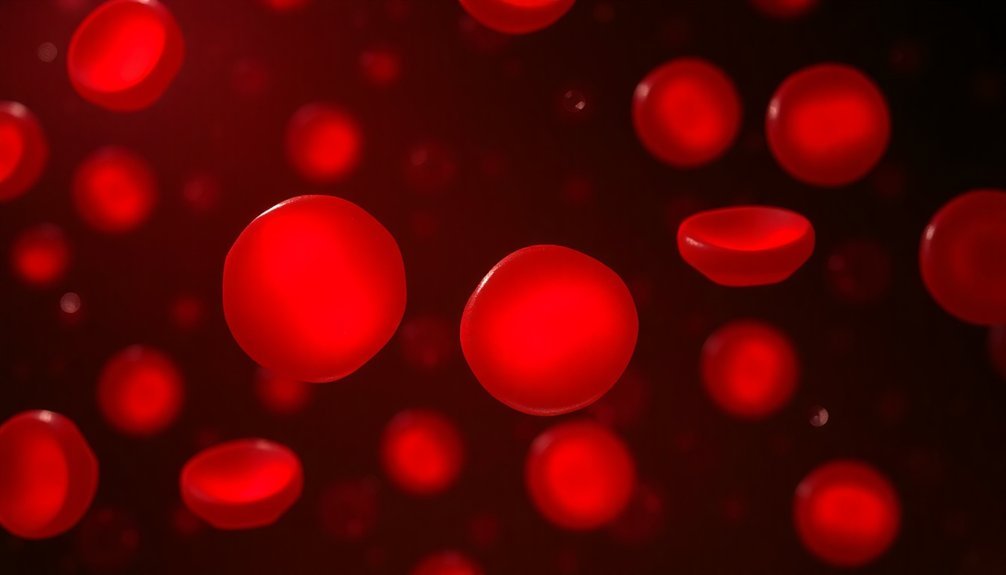
Through groundbreaking research, red light therapy has emerged as a powerful tool for enhancing blood oxygenation at the cellular level. When you undergo this therapy, it directly affects your hemoglobin's ability to bind with oxygen, increasing its oxygen-carrying capacity through a process called T-to-R state shift.
You'll find that red light therapy works through multiple mechanisms to optimize your blood's oxygen levels. It targets your mitochondria's cytochrome c oxidase, boosting ATP production and improving vasodilation.
This enhanced blood flow guarantees better oxygen delivery throughout your body, particularly benefiting your brain and other crucial organs.
The therapy's effects on your red blood cells are equally impressive. It protects them from oxidative stress and reduces their tendency to clump together.
You'll experience improved oxygen saturation and tension in your hemoglobin, while your red blood cells maintain better membrane integrity and reduced hemolysis.
These benefits make red light therapy particularly valuable if you're dealing with conditions like hypertension or cardiovascular issues. The therapy's ability to enhance blood oxygenation has been validated through experimental data, offering you a safe and effective way to optimize your blood cell health.
Frequently Asked Questions
How Does Red Light Therapy Affect Blood Clotting Rates?
Red light therapy reduces your blood clotting rates by increasing nitric oxide availability, which inhibits platelet activation and aggregation. You'll experience decreased clot formation when the therapy triggers your Period 2 protein production.
Can Red Light Therapy Help With Genetic Blood Disorders?
While red light therapy can't cure genetic blood disorders, it may help manage symptoms by improving your cellular function, reducing inflammation, and enhancing blood flow. However, you'll need more clinical research to confirm its effectiveness.
What Role Does Wavelength Selection Play in Blood Cell Treatment?
When you're treating blood cells, wavelength selection is vital – you'll want to use light around 800nm for the best measurement and effectiveness. This wavelength helps you accurately monitor cell aggregation and treatment progress.
Is Red Light Therapy Safe During Blood Thinning Medication?
You'll need to consult your doctor before using red light therapy while on blood thinners. There's a potential risk of increased bleeding, and it's not recommended without professional medical clearance for your specific situation.
How Does Altitude Affect Red Light Therapy's Impact on Blood?
At higher altitudes, you'll find red light therapy works synergistically with your body's natural adaptation to increase red blood cell production, enhance oxygen delivery, and improve blood circulation more effectively than at sea level.
In Summary
You'll find that red light therapy's impact on blood cell health stems from its ability to enhance your body's natural processes. By boosting mitochondrial function and ATP production, you're giving your blood cells more energy to perform their essential functions. When you combine this with improved circulation and reduced inflammation, you're supporting your blood cells' overall health and regeneration capabilities.

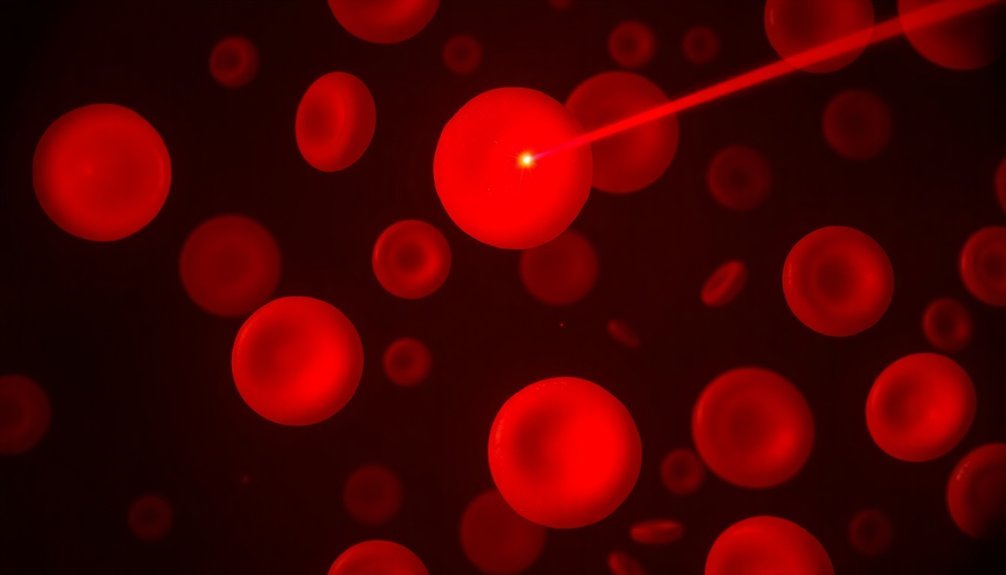



Leave a Reply